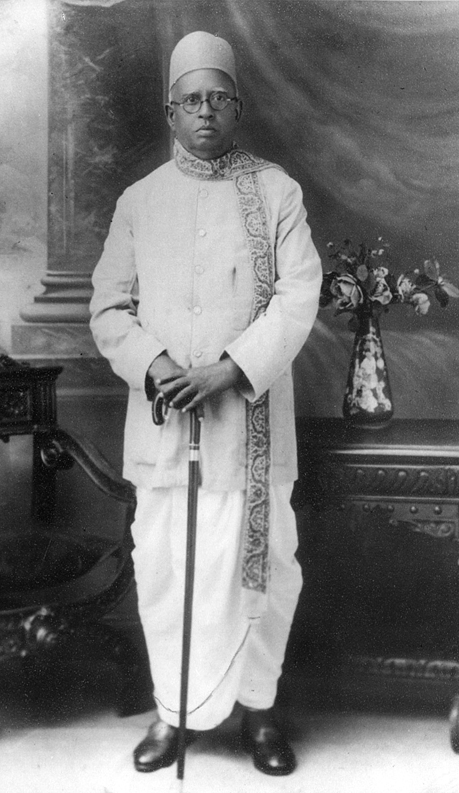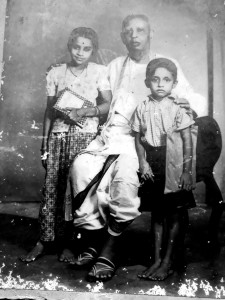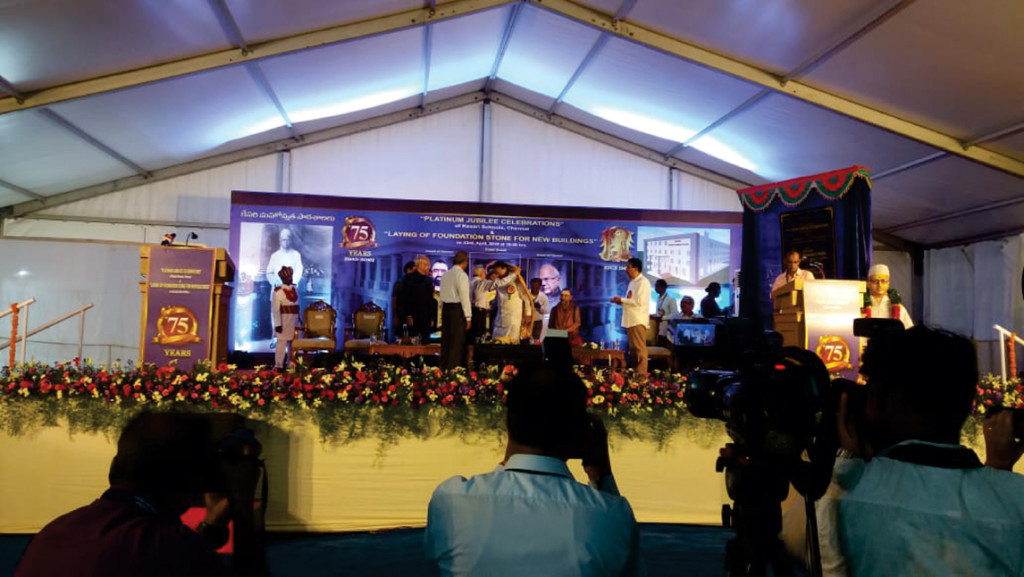Registered with the Registrar of Newspapers for India under R.N.I 53640/91
Vol. XXIX No. 6, July 1-16, 2019
Memories of a cherished grandfather
by Balakesari Komattil
Reminiscing on Dr. Kesari
On 23rd April 2019, a function was held in the premises of Kesari High School, T. Nagar to mark the Platinum Jubilee of Kesari Schools and laying of the foundation stone for a new building in T. Nagar School in which Vice-President, Mr. Venkaiah Naidu was the Chief Guest. The original programme was to have included a short talk by one of Dr. Kesari’s family members reminiscing about him and I, as a grandson of Dr. Kesari was asked to do the job. But with the function having two more VVIP guests who also desired to speak and consequent time constraints, my talk had to be axed.
Madras Musings, as well as the weekly column Madras Miscellany by late Mr. S. Muthiah in The Hindu Metro Plus have carried articles in the past on Dr. Kesari and his multifaceted contibutions to life in Madras of yore that is Chennai. In my intended talk, I had tried to capture a few recollections of my grandfather as seen through the eyes of a young boy. The same is reproduced here as an article.
– K. Balakesari

Dr. K.N. Kesari in the 1930s.
My earliest memory of my maternal grandfather Kota Narakesari, known to all as Dr. K.N. Kesari, is that of a grand old man reclining on an easy chair in the hall of our house in Royapettah, with a serious look on his face, lost in contemplation, his fingers restlessly pressing imaginary prayer beads. People were generally scared of him. No one dared disturb him except my grandmother. By the time I knew him, he had almost totally disengaged himself from the day-to-day running of his business and social activities and was largely confined to his bedroom, emerging only for his daily puja in the large hall or an occasional walk in the garden below.
Unlike today when grandchildren climb over the heads of their grandfathers and play all sorts of pranks on them, things were very different back then – grandfathers were only to be seen from a distance by the grandchildren. Even so, I remember an incident that revealed Dr. Kesari’s softer side. One day he accompanied me and my aunt to our schools in the car. I was a reluctant student and hated going to school. That day, on reaching the school, I simply refused to get down from the car, crying loudly. Grandfather calmly told the driver to take the car to a studio on the nearby Cathedral Road and had a photo (seen below) taken of him sitting with his hands resting on the shoulders of my aunt and myself on either side. Then he dropped me back home! That photo is one of my most prized possessions today. Of course I got a severe reprimand from my mother.
Dr. Kesari recalls in his autobiography that a grand sum of 10 annas was all that he inherited from his father who passed away when he was about 5 months old. How this child, born in penury in a small village near Ongole in Andhra, weathered poverty and deprivation to attain the zenith of prosperity and social recognition, sums up the life of Dr. Kesari.

Dr. Kesari with his daughter and grandson.
In his lifetime, Dr. Kesari was a man of many parts: a virtually self-taught Ayurvedic physician, a shrewd businessman, a patron of the arts, a scholar of Telugu and Sanskrit, a gardening enthusiast, printer and publisher, philanthropist, a champion of women’s social advancement and a friend equally of maharajas, future presidents and the common man.
Grandfather had a regular stream of visitors on most days as long as his health permitted, which included old friends, prominent citizens and relatives from his native Andhra. I particularly remember the day when there was some excitement when a tall bespectacled gentleman with a turban came to visit him. It was Dr. S. Radhakrishnan who dropped by to visit his old friend. That was before he became independent India’s first Vice President and later President.
Dr. Kesari was a connoisseur of good food. In fact, he would often ask for special dishes to be made for him and it was a challenge to meet his exacting specifications. Since he had worked as a cook’s assistant in his younger days before he became an Ayurvedic physician, he knew exactly what he wanted! The house always had a variety of exotic, delicious preserved fruits. And since grandmother was Malayali, gongoora and pulusukoora from Andhra happily co-existed in the kitchen alongside Kaalan and Olan from Kerala.
Grandfather was a patron of the arts and was particularly fond of Carnatic Music. In the early 1940s, Dr. Kesari let out an annexe of our Royapettah house, free of rent, to the Music Academy. At that time, it had no premises of its own and functioned from different venues, dependent on the generosity of wealthy patrons. I can still recall the strains of Carnatic music emerging from that building where music classes were conducted by the Academy. It was a remarkable reversal of fortunes for a man who, years earlier as a lonely poor boy in Madras, had to take shelter under a tree for many days, eating groundnuts to ease the pangs of hunger.

Dr. K. Radhakrishnan, eldest grandson of Dr. Kesari honouring the Vice President Shri Venkaiah Naidu with the traditional ponnadai during a function held on April 23, 2019.
Dr. Kesari launched the Telugu magazine Grihalaksmi in 1929, to provide opportunities for women writers and scholars. He also established the annual Grihalakshmi Swarna Kankanam award to honour outstanding female Telugu literary and artistic personalities. I recall that the legendary Carnatic musician Bangalore Nagarathnamma was honoured with the award on one such occasion. We children – my elder brother Dr. Radhakrishnan, a few of our cousins and I – used to look forward to this annual function which was held in the large hall in the ground floor of the Royapettah building, as we could run around and play amidst guests and the excitement of the function.
Of course the event that I remember most vividly was the Golden Jubilee celebrations in June 1951, of “Kesari Kuteeram”, the ayurvedic medicine manufacturing and marketing establishment set up by Dr. Kesari in 1900. It went on for 2 or 3 days with garden tea parties and Carnatic music performances by my aunts. On that occasion, Dr. Kesari was honoured and feted by many of his business associates, admirers and friends which included Shri. V. V. Giri, later to become President of India.
There is one memory of those days that is still fresh. Our house in Royapettah had a wooden stairway with more than 30 steps from the ground level to the first floor where Dr. Kesari stayed in his later years. As his health worsened, he could not negotiate the stairs and had to be lifted in a cane chair, fitted with wooden handles on either side, like a palanquin. Four able-bodied office staff would lift and carry him down the stairs in the chair whenever he wanted to go out. The process was reversed when he returned. It was quite a sight!
Dr. Kesari’s life symbolised national integration. Language was no barrier. Though born in Andhra, he set up business in Madras, married into a Kerala family and had a second home in Bangalore for a number of years. In our house, he used to be variously referred to as Thaataiyya, Thaatha and Sami Achan. And it was in Lodhra Press set up by grandfather, an Andhra native, that the Malayalam literary and political magazine Jayakeralam was launched in 1947 in Madras, located in a Tamil-speaking area. I wonder if we can think of such translingual collaboration today!
My mother used to recall that Grandfather was in the habit of making impulsive decisions. Suddenly one day he would say that he would like to go to Bangalore (he had a house there till the nineteen thirties) or to Kerala, and the entire household would pack up and leave by the first available train. It was one such impulsive decision when he decided to sell his house in Bangalore when someone offered him a good price. It had a beautiful garden that had won prizes in many flower shows. Almost immediately afterwards he regretted the decision as he badly missed the garden and the beautiful flowers. Fortunately the incident had a happy fallout: a few years later Dr. Kesari invested the proceeds of the sale of his Bangalore house to financially support a school in Madras set up by Telugu-speaking people for the education of their children in their mother tongue. The result of that act of philanthropy more than 75 years ago culminated in the setting up of Kesari Education Society, that today runs schools in Mylapore and T. Nagar.
The ayurvedic medicines manufacturing and marketing establishment set up by Dr. Kesari in 1900, when he wrote in charcoal on the wall of his house “Kesari Kuteeram Ayurvedic Oushadhasala” has had an uninterrupted run for the past 120 years, continuing to provide safe and affordable herbal medicines, particularly to the economically weaker sections of the society.
Today I look back on those happy, carefree years of my childhood with a mixed feeling of nostalgia and regret: nostalgia for the wonderful days gone by when Dr. Kesari was an imposing, all pervading presence in our lives, and regret that in the limited period that I knew him as a child there were not more opportunities to interact with a remarkable multifaceted personality.


Dr Balakesari is vocalist Unnikrishnan’s Periappa. I had the rare pleasure of playing in the Madras cricket league with both Unni and his father Dr Radhakrishnan. A gentle, courteous, talented family.
V Ramnarayan